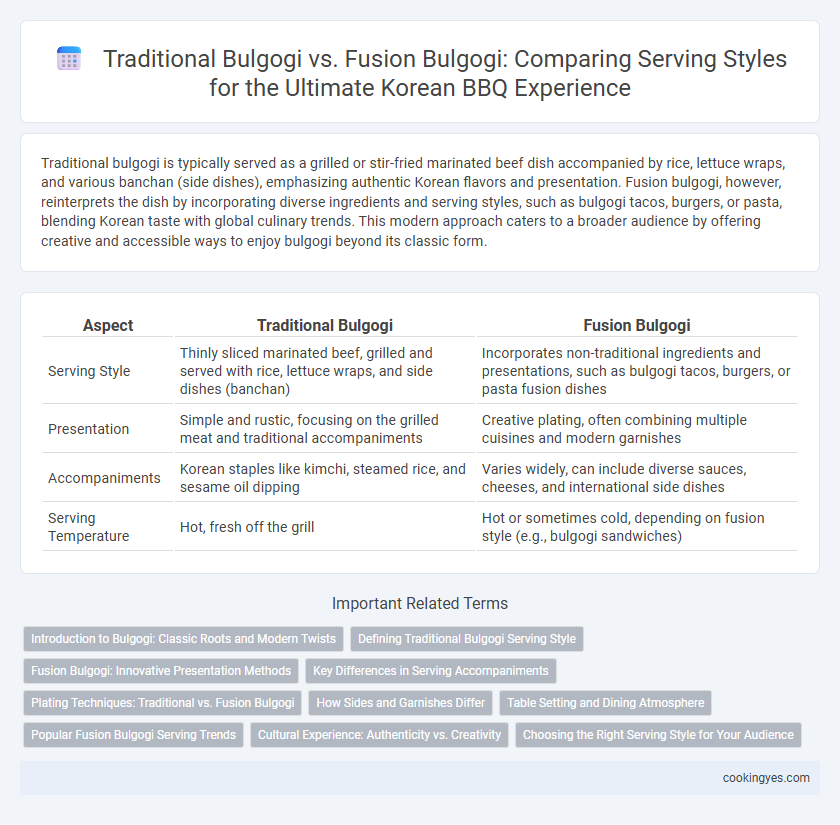Traditional bulgogi is typically served as a grilled or stir-fried marinated beef dish accompanied by rice, lettuce wraps, and various banchan (side dishes), emphasizing authentic Korean flavors and presentation. Fusion bulgogi, however, reinterprets the dish by incorporating diverse ingredients and serving styles, such as bulgogi tacos, burgers, or pasta, blending Korean taste with global culinary trends. This modern approach caters to a broader audience by offering creative and accessible ways to enjoy bulgogi beyond its classic form.
Table of Comparison
| Aspect | Traditional Bulgogi | Fusion Bulgogi |
|---|---|---|
| Serving Style | Thinly sliced marinated beef, grilled and served with rice, lettuce wraps, and side dishes (banchan) | Incorporates non-traditional ingredients and presentations, such as bulgogi tacos, burgers, or pasta fusion dishes |
| Presentation | Simple and rustic, focusing on the grilled meat and traditional accompaniments | Creative plating, often combining multiple cuisines and modern garnishes |
| Accompaniments | Korean staples like kimchi, steamed rice, and sesame oil dipping | Varies widely, can include diverse sauces, cheeses, and international side dishes |
| Serving Temperature | Hot, fresh off the grill | Hot or sometimes cold, depending on fusion style (e.g., bulgogi sandwiches) |
Introduction to Bulgogi: Classic Roots and Modern Twists
Traditional bulgogi features thinly sliced, marinated beef grilled over an open flame or on a stovetop, served with rice and side dishes like kimchi and pickled vegetables. Fusion bulgogi often reinterprets the dish by incorporating diverse ingredients such as cheese, tacos, or burgers, blending Korean flavors with international cuisine for a contemporary dining experience. Both styles highlight bulgogi's savory, sweet marinade, but fusion versions emphasize creative presentation and diverse serving formats.
Defining Traditional Bulgogi Serving Style
Traditional bulgogi serving style emphasizes thinly sliced marinated beef grilled over an open flame or stovetop griddle, typically accompanied by a variety of banchan (Korean side dishes) such as kimchi, namul, and rice. The focus is on simplicity and balance, highlighting the savory, sweet, and umami flavors of the meat without overpowering ingredients or elaborate presentation. This classic approach contrasts with fusion bulgogi, which often incorporates diverse global elements and innovative plating techniques.
Fusion Bulgogi: Innovative Presentation Methods
Fusion bulgogi redefines serving style by incorporating contemporary plating techniques such as deconstructed arrangements and edible flowers, enhancing visual appeal and dining experience. Traditional bulgogi is typically served as grilled marinated beef slices accompanied by rice and lettuce wraps, emphasizing simplicity and communal sharing. The innovative presentation in fusion bulgogi often integrates diverse culinary influences, including Korean-Mexican tacos and bulgogi sliders, elevating its versatility and modern appeal.
Key Differences in Serving Accompaniments
Traditional bulgogi is typically served with classic Korean side dishes such as kimchi, steamed rice, and ssamjang, emphasizing a balanced and authentic flavor profile. Fusion bulgogi often incorporates non-traditional accompaniments like tortillas, melted cheese, or pickled vegetables from other cuisines, creating innovative wraps or sandwiches. The key difference lies in the serving accompaniments that either preserve the cultural heritage of bulgogi or blend diverse culinary elements for a modern twist.
Plating Techniques: Traditional vs. Fusion Bulgogi
Traditional bulgogi is typically served on a simple plate or stone pot, emphasizing hearty presentation with sliced marinated beef arranged uniformly alongside steamed rice and kimchi, highlighting its home-style comfort appeal. Fusion bulgogi plating experiments with modern aesthetics, often incorporating minimalist arrangements on sleek dishes, accompanied by garnishes like microgreens, edible flowers, and unexpected sides like mashed avocado or truffle oil drizzle. This contrast in plating techniques underscores traditional bulgogi's rustic character versus fusion bulgogi's emphasis on visual sophistication and innovative flavor pairing.
How Sides and Garnishes Differ
Traditional bulgogi is typically served with a variety of classic Korean sides such as kimchi, steamed rice, and simple vegetable banchan like pickled radishes and spinach. Fusion bulgogi often incorporates non-traditional accompaniments like avocado slices, cheese, and artisan bread, reflecting a blend of global culinary influences. The garnishes in traditional servings emphasize freshness and fermentation, whereas fusion versions highlight creativity and diverse textures.
Table Setting and Dining Atmosphere
Traditional bulgogi serving style emphasizes a communal table setting with shared side dishes (banchan), a grill at the center for cooking, and a warm, rustic atmosphere reflecting Korean heritage. Fusion bulgogi often features individual plating with creative presentations, modern tableware, and a contemporary dining environment designed for a more casual or upscale experience. The contrast highlights traditional bulgogi's focus on social dining and intimacy versus fusion interpretations prioritizing innovation and visual appeal.
Popular Fusion Bulgogi Serving Trends
Traditional bulgogi features thinly sliced marinated beef grilled or pan-cooked and served with rice and leafy vegetables, emphasizing simple and authentic flavors. Popular fusion bulgogi serving trends include bulgogi tacos, bulgogi burgers, and bulgogi pizza, blending Korean flavors with Western culinary styles to appeal to diverse palates. These innovative presentations highlight the adaptability of bulgogi while maintaining its signature sweet and savory profile.
Cultural Experience: Authenticity vs. Creativity
Traditional bulgogi emphasizes authentic preparation and serving styles, featuring thinly sliced marinated beef grilled over a charcoal fire and served with classic Korean side dishes like kimchi and rice to preserve cultural heritage. Fusion bulgogi experiments with diverse ingredients and presentation, integrating global flavors and contemporary plating techniques to offer a creative, modern dining experience. Both styles highlight Korean cuisine, but traditional bulgogi prioritizes cultural authenticity while fusion bulgogi showcases innovation and culinary evolution.
Choosing the Right Serving Style for Your Audience
Traditional bulgogi is typically served sliced and marinated beef grilled over an open flame, accompanied by rice and kimchi, offering an authentic Korean dining experience. Fusion bulgogi incorporates creative presentations such as bulgogi tacos, burgers, or sliders, appealing to diverse palates and modern settings. Choosing the right serving style depends on your audience's preference for cultural authenticity or innovative, casual dining options.
Traditional bulgogi vs fusion bulgogi for serving style Infographic

 cookingyes.com
cookingyes.com